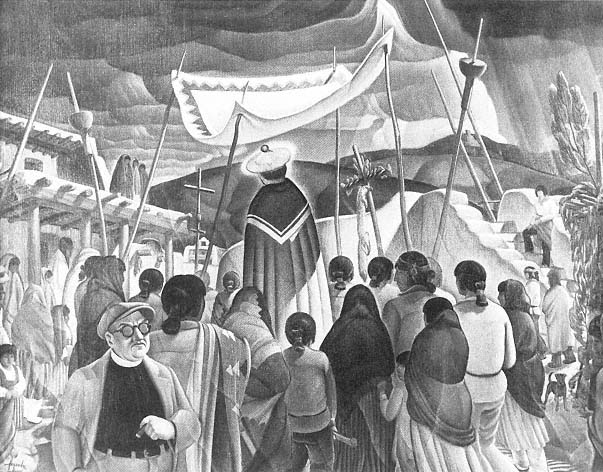Epilogue
And what of the state of churches in New Mexico today? Certainly the Hispanic American communities, even small communities such as San Ysidro or Sena, display a sincerity of belief and a care for their church that are deep-rooted and pervasive. But these communities must still face the deterioration of the body of the church, isolation, and, more recently, a lack of clergy.
In 1916 Father Jerome Hesse, in describing Christmas at Santo Domingo, said that the pueblo's was certainly Catholicism but Catholicism in a different form: "The inhabitants of this Pueblo are Catholic, and wish to be Catholic, but according to their own fashion."[155] John Bourke had been less gracious in 1881, commenting, "The Pueblos became hypocrites, they never became Catholics." And he added, "Coercion never yet made a convert."[156]
The native Pueblo religions have been a continuous presence in New Mexico since the beginning of habitation. Even today the situation does not seem to have changed. Edward Dozier offered this explanation:
The new religion [Catholicism] provided no institutions for the relief from [the] immediate and pressing anxieties of daily life. Instead the new religion dwelt on incomprehensible rewards or punishments in the life after death. In Pueblo belief, conduct in the temporary world did not determine the kind of existence one might have in the hereafter. There was no concept of heaven or hell; one lived on after death but no rules existed here and now for improving or worsening one's position in the next world. Life was difficult enough in this world. Let the future take care ofitself. So loyalty in the native beliefs and its rites persisted. The Pueblo Indian accommodated himself to the external practices of the new religion for the simple expedient of survival, but his own indigenous religion was not abandoned.[157]
Lummis added, "The nine thousand Pueblo Indians—peaceful, fixed, house-dwelling and home-loving tillers of the soil; good Catholics in the churches, they have build with a patience infinite as that of the pyramids; good pagans everywhere else."[158]
One hot day in August 1981 when I began working on this book, I traveled to one of the Rio Grande pueblos to take a careful look at the church and village because the community permitted no photography or note taking. As it was a Sunday morning, I thought I might be able to attend mass and thus gain access to the interior of the church, which had remained locked on several previous visits. Arriving about ten o'clock, I found the gates to the campo santo securely locked. Peeking through the gate, I noticed that the doors of the church were also firmly closed to entry.
Rejoining a friend, I walked over to the plaza where the sound of drumming attracted our attention. In the plaza were a group of koshare , clowns or "delight makers," as Adolph Bandelier called them,[159] indicating that a dance was in progress. Our initial panic as the only two Caucasians in the area was dispelled when several members of the community courteously told us that we were welcome to remain and watch the dance, although it had not been announced to the general public. Shortly thereafter the dancers filed into the dance plaza. Their intricate steps to the rhythm of the drum and the shifting of columns continued for several hours. Like the feeling I encountered in the Hispanic villages, the dancers' sincerity was without question, although the Koshares' comic antics displayed none of the staid solemnity of ritual in the Western church.
What should one make of this? A tentative explanation might suggest that each of the two religions has governed certain aspects of human existence and that after centuries of Western contact the native religion, the religion of the ancestors, still remains a strong presence in the lives of the people. D. W. Meinig put it more strongly: "Although the Catholic Church was a prominent part of the visible scene, it was rarely centered either in location of allegiance, in some villages nominally accepted, in others largely ignored, in all at most no more than co-existing with the kiva and the ancient rituals."[160] The Catholic church still stood, but it was locked. Its presence has been tolerated and at times even venerated. The church has lived in New Mexico for three centuries, a long period of time in terms of European presence in the Western Hemisphere but only a short period of time in the Pueblo sense of existence. Place, not a particular structure, remains sacred in New Mexico; the spirit, not the stone.
1–48
Procession of The Saint, Santo Domingo
Alexandre Hogue, 1928
In this painting the saint belongs to the people, although the priest's attention appears to be directed elsewhere.
[Sheldon Memorial Art Gallery, University of Nebraska, Lincoln, Nebraska Art Association, Nelle Cochrane
Woods Collection]
